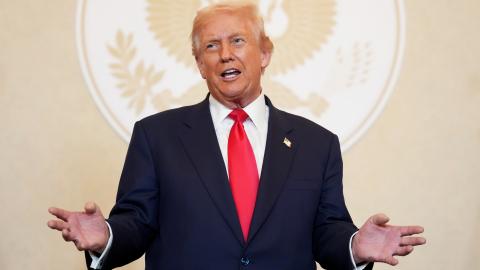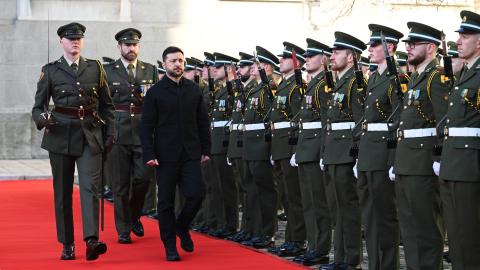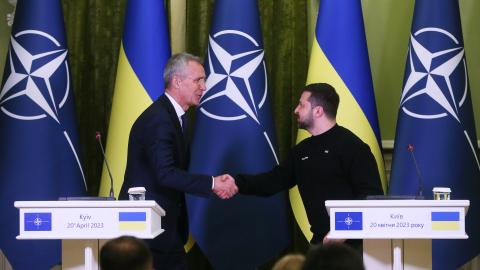NATO will hold a major summit in Vilnius, Lithuania, from July 11 to 12, and Ukraine will undoubtedly be a top agenda item. Ukrainian Foreign Minister Dmytro Kuleba recently said that the summit should present “a clear plan on when and how Ukraine will enter [NATO].” Meanwhile, Ukrainian Defense Minister Oleksii Reznikov said that “there is no alternative to Ukraine's accession to NATO.” With expectations high, NATO leaders and policymakers need to start developing a plan to keep Ukraine on the path to eventual membership while deepening NATO-Ukraine relations. With some creative thinking and political will, the summit could serve NATO’s interests and meet the Ukrainian government’s reasonable and understandable expectations.
Ukraine and NATO: A Brief Overview
NATO and Ukraine have had a formal relationship for more than three decades. Soon after regaining independence, Ukraine joined the North Atlantic Cooperation Council in 1991 and NATO’s Partnership for Peace (PfP) program in 1994. In the alliance’s 1995 “Study on NATO Enlargement,” Ukraine was the only country of the former Soviet Union or Warsaw Pact mentioned by name:
We want to develop further our relations with all newly independent states, whose independence and democracy constitute an important factor of security and stability for Europe. In this context, we attach particular importance to our relations with Ukraine which we will further develop, especially through enhanced cooperation within the PfP.
In 1997, the NATO-Ukraine Commission was established to direct relations between Ukraine and NATO and facilitate high-level discussions on security topics of mutual concern. The Bucharest Summit Declaration in 2008 stated that the alliance “welcomes Ukraine’s and Georgia’s Euro-Atlantic aspirations for membership,” agreed that the countries “will become members of NATO,” and noted that “both nations have made valuable contributions to Alliance operations.” However, NATO did little to move Ukraine toward NATO membership in the years that followed, even though the alliance did take steps to improve Ukraine’s military after Russia’s first invasion in 2014. In June 2020, the North Atlantic Council recognized Ukraine as an “Enhanced Opportunities Partner” and said that “this decision recognises Ukraine’s strong contributions to NATO missions.”
On September 30, 2022, President Volodymyr Zelenskyy announced that Ukraine would seek an “accelerated” NATO membership application process. This was in response to Russian President Vladimir Putin illegally annexing the Donetsk, Luhansk, Kherson, and Zaporizhzhia regions of Ukraine during a sham ceremony in Moscow. Since Zelenskyy’s announcement, little progress has been made regarding Ukraine’s path to eventual NATO membership, and the United States and Western Europe have shown little enthusiasm for this endeavor.
Ukraine and the Vilnius Summit
Since 2014, the Ukrainian people have proven on the streets of the Maidan, through the ballot box, and on the battlefield that they see their future connected to the West, not under Russian domination. NATO membership is a key component of Ukraine’s Euro-Atlantic future.
There should be three clear and unequivocal messages coming out of the Vilnius summit: (1) Ukraine will someday be in NATO; (2) there will be a mutually agreed upon path for membership; and (3) Russia does not have a say in the matter. Although it might be tempting, NATO should not recycle the stale and tired wording first used 15 years ago in the 2008 Bucharest Summit Declaration—and repeated in just about every summit since—regarding Ukraine’s membership.
Here are seven realistic, achievable, and practical policy proposals for the Vilnius summit to keep Ukraine on the path to NATO membership:
1. Ensure that a NATO-Ukraine Commission meeting takes place at the heads-of-state or government level during the summit. Traditionally, when there is a NATO-Ukraine Commission meeting during a NATO summit, it normally takes place at the foreign ministers level. Doing so at Vilnius would send the wrong signal to the Ukrainian people. At the Vilnius summit, a NATO-Ukraine Commission should be held at the heads-of-state or government level to demonstrate the importance with which NATO views its relationship with Ukraine.
2. Develop and offer Ukraine a new Tailored Action Plan to replace the outdated Membership Action Plan (MAP). When charting a path for the remaining aspirant countries wanting to join the alliance,1 NATO needs a fresh approach. The MAP process worked well during the early stages of NATO enlargement after the end of the Cold War, primarily because the aspirant countries had relatively straightforward geopolitical circumstances. However, the remaining countries that hope to join face very different circumstances and require more of a bespoke approach. Whereas MAP started out as a technical way to bring an aspirant country into the alliance, some members now use it as a technicality to stop enlargement. So NATO should jettison the outdated MAP process and develop a Tailored Action Plan for Ukraine. This new approach would be tailored to Kyiv’s unique geopolitical circumstances, breathe new life into the enlargement process, and give Ukraine concrete benchmarks to meet before an invitation for membership is formally extended.
3. NATO should publish a separate summit declaration on fostering NATO-Ukraine relations and Ukraine’s path to membership. In addition to the main declaration, NATO leaders often agree on separate declarations that cover specific issues of importance during a summit. Russia’s large-scale and unprovoked invasion of Ukraine has changed the security environment in Europe in a way not seen since World War II. This warrants a separate declaration that should focus on NATO’s strategy and support for Ukraine, NATO and Ukraine’s deepening relations, and Kyiv’s path to membership. A separate summit declaration of this nature would send a message to the Ukrainian people that the alliance takes the situation seriously.
4. Create a NATO-certified Center of Excellence on Modern Warfare jointly with Ukraine. For the past two decades, NATO has primarily focused on low-intensity conflict and counterinsurgency operations. Now the alliance faces a different environment. NATO’s recent Strategic Concept stated that “the Russian Federation is the most significant and direct threat to Allies’ security and to peace and stability in the Euro-Atlantic area.” NATO members need to learn the hard-earned lessons from the war in Ukraine. Creating a Center of Excellence on Modern Warfare would be a good way to start this process. The center would provide an opportunity for allies to engage in meaningful dialogue and training on how to address the challenges associated with state-on-state warfare in the twenty-first century. Additionally, it would offer another opportunity for the NATO and Ukrainian flags to fly together.
5. Invite Ukraine to contribute troops to the NATO Response Force. Of course, Ukraine is fighting a war of national survival and needs every available soldier on the front lines. However, at any given time thousands of Ukrainian soldiers are outside Ukraine being trained across Europe and the US. If Kyiv so desired, NATO should invite Ukraine to designate a small number of forces already outside Ukraine for training to be certified by NATO and earmarked for NATO Response Force duties. Ukraine has contributed a small number of troops to the NATO Response Force in the past, so there is a precedent.
6. Announce that a special North Atlantic Council (NAC) meeting will take place in Ukraine.The NAC is the principal decision-making body inside NATO, and the secretary general chairs its meetings. A special NAC in Ukraine would bring immediate firsthand awareness of the war to the alliance. Such a meeting would also be symbolically important. Ideally, it would take place in Kyiv, but if the logistics make this impossible, then Lviv would be a suitable alternative.
7. Create a Train Today for Tomorrow trust fund for Ukraine. During the 2014 summit in Wales, NATO established six trust funds on various issues to help Ukraine improve its armed forces.2 Today, three trust funds remain active: Command, Control, Communications and Computers (C4); Medical Rehabilitation; and Professional Development Programme. NATO should announce the creation of a new Train Today for Tomorrow trust fund. The goal would be for NATO members to start training Ukrainians on advanced weapons systems that the allies do not currently have plans to provide—obvious examples include fighter jets and advanced unmanned aerial vehicles. This way, if NATO members finally decide to supply Ukraine with these systems, Ukrainians will be ready to operate them immediately instead of having to be first trained.



















